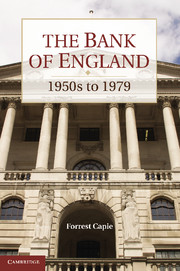Book contents
- Frontmatter
- Contents
- List of Illustrations
- List of Figures
- List of Tables
- Foreword by Mervyn King
- Preface
- Acknowledgements
- Abbreviations and Acronyms
- 1 Introduction and Overview
- 2 The Bank in the 1950s
- 3 The Monetary Setting and the Bank
- 4 The Bank's External Responsibilities to 1964
- 5 From Crisis to ‘Crucifixion’
- 6 Domestic Monetary Policy after Radcliffe
- 7 Other Activities and Performance
- 8 Sterling from Devaluation to Smithsonian
- 9 The Road to Competition and Credit Control
- 10 Competition and Credit Control
- 11 The Secondary Banking Crisis
- 12 Banking Supervision
- 13 Monetary Targets and Monetary Control
- 14 The Bank and Sterling in the 1970s
- 15 The Bank's Freedom to Operate
- 16 Epilogue
- Bibliography
- Index
- Titles in the series
11 - The Secondary Banking Crisis
Published online by Cambridge University Press: 05 July 2011
- Frontmatter
- Contents
- List of Illustrations
- List of Figures
- List of Tables
- Foreword by Mervyn King
- Preface
- Acknowledgements
- Abbreviations and Acronyms
- 1 Introduction and Overview
- 2 The Bank in the 1950s
- 3 The Monetary Setting and the Bank
- 4 The Bank's External Responsibilities to 1964
- 5 From Crisis to ‘Crucifixion’
- 6 Domestic Monetary Policy after Radcliffe
- 7 Other Activities and Performance
- 8 Sterling from Devaluation to Smithsonian
- 9 The Road to Competition and Credit Control
- 10 Competition and Credit Control
- 11 The Secondary Banking Crisis
- 12 Banking Supervision
- 13 Monetary Targets and Monetary Control
- 14 The Bank and Sterling in the 1970s
- 15 The Bank's Freedom to Operate
- 16 Epilogue
- Bibliography
- Index
- Titles in the series
Summary
British banking had been enormously stable from the third quarter of the nineteenth century until the 1970s. The stability is frequently explained casually as a consequence of the cartel. But there was no cartel before 1914, and even through the twentieth century, the rate of return on capital in banking was not out of line with that in the rest of the economy, a feature more in keeping with a competitive model than a monopolistic one. Of course, there are many possible explanations for that and many ingredients in the stability. Importantly, the banks had found their own way to the appropriate capital, cash, and liquidity ratios. After the Second World War, the latter two were to change under direction from the authorities. And while it was not spelled out in these terms at the time, the Bank took responsibility for financial stability. The fact that the banking system had been so stable for so long meant that the subject was little discussed. The fact was, though, that the Bank watched over all that went on in the City and gathered intelligence on everything from mood to individual behaviour. The key figure in this in the Bank was the Principal of the Discount Office. That job was becoming more difficult in the world after competition and credit control (CCC) and came under close scrutiny in the secondary banking crisis that broke at the end of 1973, one of the most dramatic events in an eventful decade in which the Bank was involved.
- Type
- Chapter
- Information
- The Bank of England1950s to 1979, pp. 524 - 586Publisher: Cambridge University PressPrint publication year: 2010



